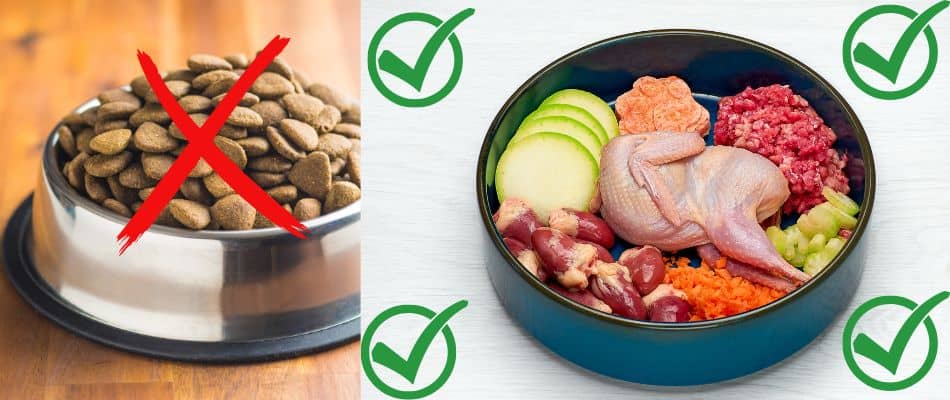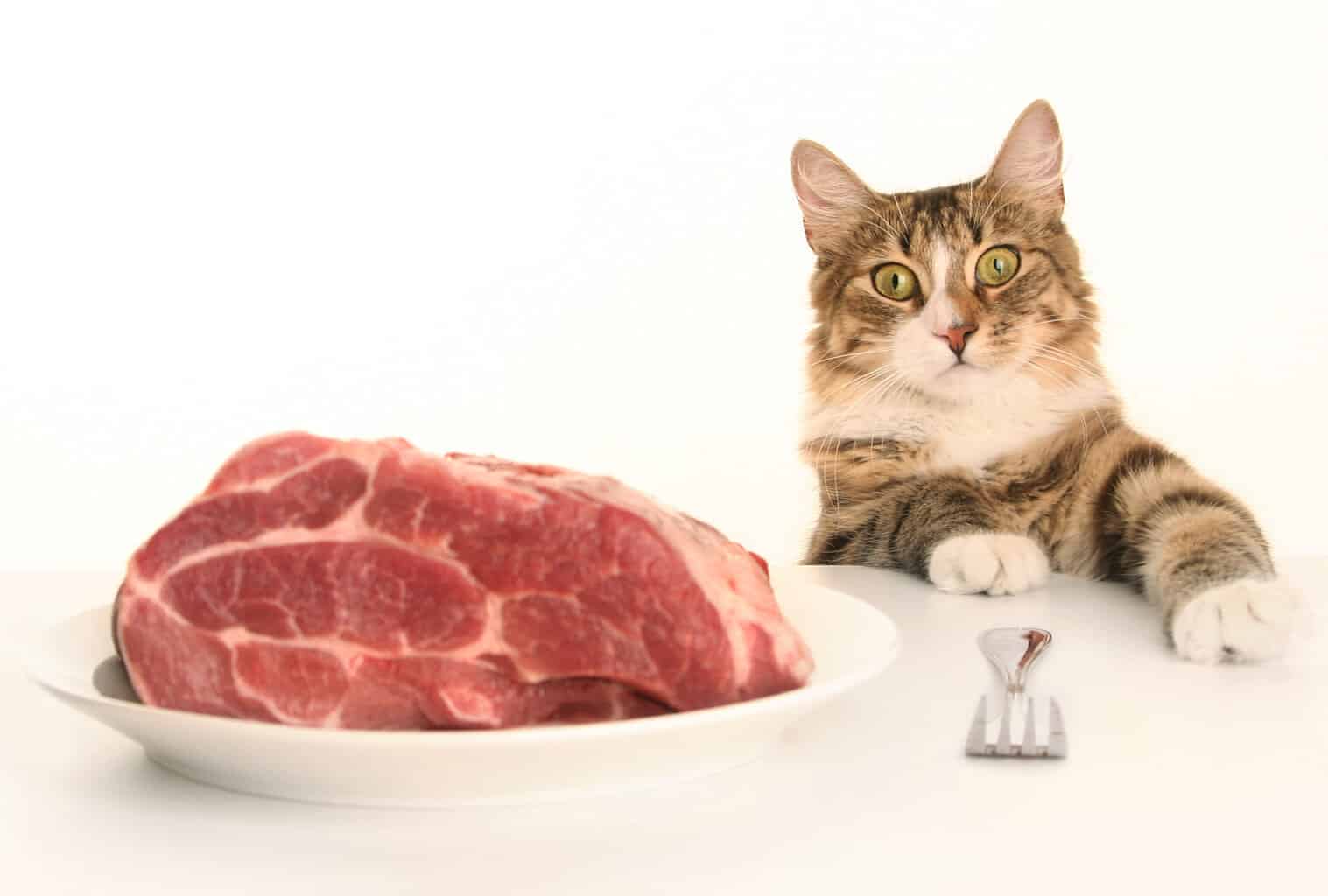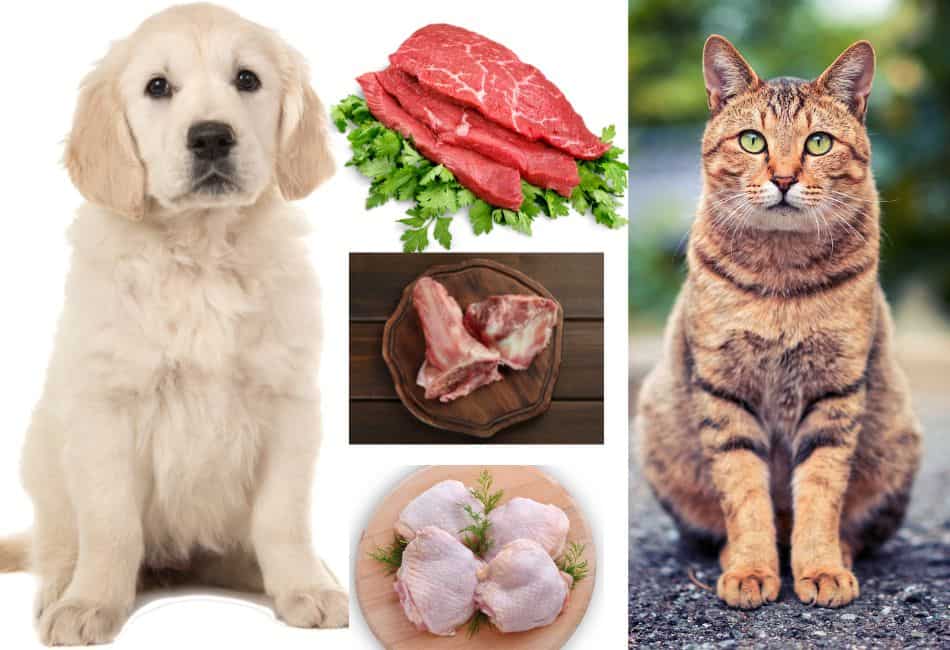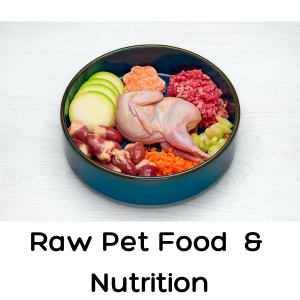Table of Contents
What Is a Raw Food Diet?
Not a Trend but True Nutrition
BARF and Dr. Billinghurst
BARF Is Species-Specific
Dispelling Myths of Raw Food
Why Kibble Isn’t Food
The Role of Living Enzymes Found in Raw Food
Why Raw Bones Are Necessary
Types of Raw Bones
Any Age Is the Right Age
How Raw Nutrients Affect the Mind
Well-Being, Behavior, and Training
How To Transition from Kibble to Raw
Cleansing Effect of Raw Food
Signs of Wellness Unfolding
How to Start
References
What Is a Raw Food Diet?
One of the things that make animal families different from one other is diet. Each family has unique nutritional needs based on available foods in the natural environment. Tens of millions of years ago, the cat family specialized in climbing, pouncing, and grabbing. On the other hand, the canid family adapted to the drying climate by chasing prey running on the plains. As a result, dogs’ ancestors evolved sensitive noses, strong legs built for speed, and stamina to hunt for hours on end.
Their digestive systems were able to make use of all parts of prey: not only muscles and bones, but also organs such as the liver and brain, and stomach with contents. For added moisture and nourishment, these predators also consumed seasonal fruits, grasses, nuts, and other plant material.
This varied diet was fresh, raw, and nutrient-dense.
Not a Trend but True Nutrition
As a species, we enjoy cultural fads: trying new things and enjoying the prestige of flaunting the latest cultural whims. However, the raw food diet is no trend — it’s been around since life began. Cooking is a recent behavior practiced only by human-type critters. Heat does make certain foods easier to chew and absorb, but that only matters to animals lacking the ability to digest large fibrous chunks.
Canines need raw food to keep their teeth clean and their jaw muscles strong. Gnawing is an instinctual activity providing stress relief and recreational pleasure. Manufactured pet foods are highly processed. Although they contain added nutrients, many are incomplete, altered by heating, and produced by whatever method is cheapest and fastest.
BARF and Dr. Billinghurst
An increasing number of pet nutritionists are supporting the idea of the BARF diet. The word “diet” in common use refers to a temporary change in one’s eating habits, especially to lose weight. The true definition describes one’s usual nutritional intake. BARF is an abbreviation for Biologically Appropriate Raw Food.
Australian veterinarian Dr. Ian Billinghurst, founder of the BARF diet, believes in health benefits from nature: clean air, clean water, sunshine, live plants, and raw, uncontaminated foods. The right diet for pets and humans alike, he contends, is not about maintaining their existence at the lowest mass-production cost, but about promoting maximum health, energy, and mental functioning.
Click Here for Dr. Billiinghurst’s Book
BARF Is Species-Specific
Since no single pet food meets all pets’ needs, the BARF diet is adjusted to provide the appropriate nourishment for each species according to age, health condition, weight, and activity level.
For example, kittens have developing immune systems along with rapid growth, so they require a diet that’s different from that of a nursing mother, a feral adult cat in the wild, and an aging cat with diabetes. Similarly, while horses and cattle are both foragers, they don’t digest fiber the same way. The equine system has only a single-chambered stomach requiring very specific plant types. Cattle are ruminants that chew cud and ferment fiber in their four-chambered stomachs. Providing only cattle feed to horses can be fatal.
Some meat-eating animals are obligate carnivores, meaning that they are obligated to consume animal products because their bodies can’t manufacture particular nutrients. Taurine, an essential amino acid found only in proteins from animal sources, legally must be added to processed cat food. Cats are unable to store taurine so it needs to be eaten regularly. A raw cat food diet provides taurine from organ meats in its freshest form.
Dogs are considered facultative carnivores: they prefer a variety of meats for most of their dietary intake, but their digestive systems have additional enzymes to break down carbohydrates to extract necessary ingredients. Omnivores are opportunistic, eating whatever is available. Facultative carnivores prefer meat but incorporate other types of edibles.
As you can see, there is no single BARF formula, but several raw pet food variations to meet the needs of each beloved critter.
Dispelling Myths of Raw Food
Some people fear using raw pet food, wrongly believing it to be dangerous. One myth is the presence of salmonella and other biological contaminants. Nutritious food isn’t dangerous unless improperly handled by humans. Foodborne illnesses are prevented by awareness of the environments promoting the growth of microorganisms. BARF principles, when carried out correctly and consistently, mandate the use of clean, fresh foods from reliable sources.
Another phobia relates to bones. While cooked bones are extremely dangerous because they’re dry and splinter like wood, in the wild raw bones are essential for health. Powerful molars slice soft bones into small, easily digestible pieces, providing iron-rich marrow, fats, collagen and other proteins, and several minerals. Larger bones are essential for dental health because gnawing removes tartar and strengthens the tooth roots anchored in the jaw.
Humans often start out with good intentions but become lax in their food-handling practices. Too often raw food itself is blamed for causing problems. Sadly the same situation occurs with “unmanageable” dogs left at the dog pound when the cause is human failure to provide training.
Why Kibble Isn’t Food

Kibble (a trendy word for animal chow) is usually a uniform, heated, dried food mixture of cheap ingredients formed into bite-sized nuggets. Kibble is designed for the convenience of manufacturers and pet owners wanting to store non-perishable feed. The issue is that most kibbles are highly processed, resulting in the loss of many nutrients.
Not only does heating break down many vitamins and proteins, but the addition of carbohydrate fillers such as corn meal overloads the kibble with extra calories. Preservatives, artificial flavors, and colorings appeal more to the purchasers than the pets.
Although processed food temporarily satisfies an animal’s hunger, it isn’t nutrient-dense enough to last long. BARF-type diets pack more punch per pound because they’re what nature intended, so they’re easily absorbed. Your pet not only feels more satisfied but poops less.
The Role of Living Enzymes Found in Raw Food

Although human and canine bodies manufacture most necessary enzymes, consuming raw fruits and vegetables provides a healthful enzyme boost. What’s more, fresh, raw organ meats from reliable disease-free sources offer many other benefits. BARF raw dog food and cat food contain approximately 10-15% organ meat, half of that liver.
Dogs and even cats can also benefit from small quantities of fermented food such as plain kefir, yogurt, and sauerkraut.
Why Raw Bones Are Necessary
Raw bones are a natural part of carnivorous and omnivorous diets. They’re not only the highest-ranking sources of minerals, but they also contain several different proteins. Did you know that archaeologists have evidence of early humans grinding the entire carcasses of birds and other small animals as part of their food preparation?
Check out our Happy Tails article on why your dog needs raw chicken bones. Since raw bones are soft, they’re flexible and not likely to splinter the way brittle cooked bones will. They help satisfy the natural predatory urge to chew, calming the spirit at the same time.
Speaking of calming the spirit, providing a large raw bone for short-term supervised chewing may result in the bone suddenly disappearing. That’s a good thing because dogs are driven to save carcass parts from scavengers by burying them, anticipating the pleasure of digging up the hidden treasure later.
The scientific explanation behind the calming effect of raw bones is that the act of chewing appears to suppress the production of certain stress hormones, stimulates the production of certain endorphins, and improves some cognitive functions. In humans, chewing gum during prenatal stress may even reduce the likelihood of learning disabilities in the offspring.
Types of Raw Bones
Opinions vary on bones, but the main consideration is safety. Always offer a meaty bone for a short amount of time in your presence to watch for dental problems or choking. Prevent other pets, especially other dogs, from being around. Offer beef tails or small bones such as poultry or rabbit necks initially, preferably after your dog has eaten so the bone won’t be impulsively gulped down. Since too much bone in the diet can cause constipation or intestinal blockage, give raw bones occasionally at first and always monitor stools.
Use the freshest bones available, preferably from a local butcher rather than a chain grocery store. The most nutritious bones still have meat, gristle, membranes, fat, and marrow. Be sure to refrigerate or freeze whatever is left to minimize bacterial growth.
Since the process of weight-bearing — standing and moving — increases bone density, the leg bones of large grazing animals such as cattle or bison are ideal for hours of pleasurable gnawing. Hollow marrow cavities can be stuffed with unsweetened peanut butter or moist dog food for added enjoyment.
Healthful replacements for chemical-laden rawhide, a variety of raw bones are good for your dog.
Any Age Is the Right Age
Here are two basic principles of good health: one is that beneficial practices can be started at any age. The other is that changes of any kind are often most effective when started gradually. Switching to a BARF-type diet is no exception. Studies show that all pets can show improvement with a fresh, natural, balanced diet, but if digestive issues are significant, more time may be needed to adjust to the changes.
How Raw Nutrients Affect the Mind
It’s not surprising that many nutrition experts celebrate “raw food for a better mood.” We all feel better when we’re healthy. Daily well-balanced nutrition not only supports the brain but also the circulatory system that keeps the brain oxygenated. All the systems work together. The brain itself needs plenty of fresh, clean water as well as omega-3 fatty acids found in fatty fish (especially salmon and sardines), seaweed and algae, and Brussels sprouts.
Well-Being, Behavior, and Training
Well-known studies document that children do better in school when they start the day with a nutrient-dense breakfast. In addition to fueling the brain, daily nutrition promotes a feeling of safety and security, decreasing fear, and increasing self-confidence. Can there be an easier way to cultivate your pets’ calmness and receptivity to new learning? Being awake and alert creates more teachable moments for effective training.
How To Transition from Kibble to Raw
Wait for a time when your household is generally peaceful and there are no major events or distractions for you or your pet. Some people opt for a quick switch after their dog or cat goes on a 24-hour fast. Others omit the fast and extend the transition to a week or two, substituting small portions of raw food for kibble. Many pets respond eagerly to bites of BARF-style food as rewards or treats. Poultry and rabbit can be more digestible than other meats and may be a good place to start.
As the transition progresses, your pet may seem hungrier than usual because kibble expands inside the stomach. It takes less raw food to provide nutrition because it is nutrient-dense. Your pet will eventually adjust as well-being increases. Digestive upsets aren’t unusual, so don’t be alarmed if you observe some nausea, gas, and/or loose stools. The “good bacteria” in the intestines require a little time to adjust to the new foods.
Cleansing Effect of Raw Food
In the beginning, when switching to a raw food diet the nutrients are highly absorbed by the body and will begin cleansing and clearing out what does not belong there. It’s quite amazing how the correct food will automatically begin to heal the body. It can throw off toxins, chemicals, pathogens, heavy metals and other things never designed for the body. There can be a temporary cleansing response of diarrhea and or vomiting.
This is NOT the food itself but the healing quality of integrating a raw food diet. This period can last for a week or two and even be off and on. This is very important to understand. The gut flora is also rebalancing itself due to the introduction of living enzymes within the raw food.
Because raw food lacks fillers and is pure nutrition, you’ll notice bowel movements being much smaller this is normal. Another added benefit is that the poop is much less odiferous!
Signs of Wellness Unfolding

Over the next weeks, more health benefits will become apparent. A stronger immune system means fewer ear infections, cleaner teeth, better breath, more supple skin with few flakes, a shinier coat that smells naturally fresh, gradual weight loss, a more relaxed gait, bouncier energy, and a happier mood. All that.
How to Start
To learn more about how the world will change for you and your dog or cat, look at Dr. Billinghurst’s book, The BARF Diet: Restoring Animal Wellness Using Evolutionary Principles — Raw Feeding for Dogs & Cats. The first chapters provide scientific backup for the principles of the BARF diet, also discussing many of the health benefits in detail.
The second part of the book explains the meaning of the concept of “complete and balanced” feeding. Not only does it address fears often attached to raw foods, but it provides directions on switching from kibble and several recipes to try.
Although Dr. Billinghurst has written several books throughout his career, this one is the primer and go-to source for learning about the Biologically Appropriate Raw Diet.








